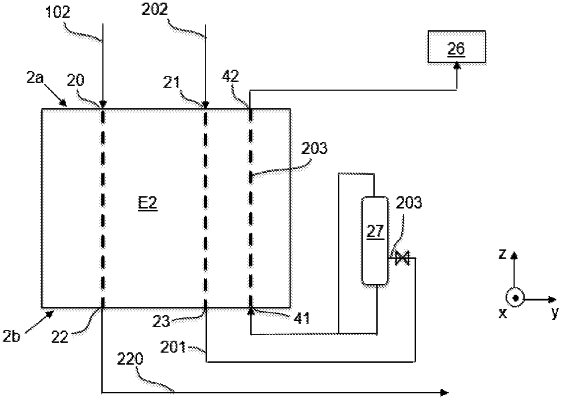| CPC F25J 1/0022 (2013.01) [F25J 1/0057 (2013.01); F25J 1/0262 (2013.01)] | 8 Claims |

|
1. A method for liquefying a hydrocarbon stream using a heat exchanger comprising a plurality of plates parallel to each other and to a longitudinal direction that is substantially vertical, said exchanger having a length measured in the longitudinal direction, the plates being stacked with spacing so as to define between them at least one first series of passages for the flow of at least part of a two-phase cooling stream vaporizing by exchanging heat with at least the hydrocarbon stream, said method comprising:
a) introducing the hydrocarbon stream into the heat exchanger;
b) introducing a cooling stream into the heat exchanger via at least one first inlet thereby passing through the heat exchanger and exiting from a first outlet, said first inlets and first outlet being arranged so that the cooling stream flows through the exchanger in a downward along the longitudinal direction;
c) discharging the cooling stream via the first outlet of the exchanger;
d) expanding the cooling stream originating from step c) so as to produce a two-phase cooling stream;
e) reintroducing at least part of the two-phase cooling stream into the heat exchanger via at least one second inlet thereby passing through the heat exchanger and exiting from a second outlet, said second inlets and second outlet being arranged so that said at least part of the two-phase cooling stream flows through the passages of the first series in an upward direction oriented in the longitudinal direction;
f) vaporizing said at least part of the two-phase cooling stream in the passages of the first series by exchanging heat with at least the hydrocarbon stream, so as to obtain an at least partially liquefied hydrocarbon stream at the outlet of the exchanger,
wherein at least one passage of the first series comprises a heat exchange structure comprising a plurality of series of fluid guiding walls, said series of fluid guiding walls following each other in the longitudinal direction and having leading edges, which extend orthogonally to the longitudinal direction so as to fully or partly face the two-phase cooling stream, said fluid guiding walls having leading edges which decrease in cross-sectional area as they traverse the heat exchange longitudinally from a bottom to a top vertically.
|